
























Ever see a commercial harbor full of Furuno Marine Electronics and wonder why the pros rely on us?





See why here










Are you ready to embark on your next on-water adventure? Before you set sail, here are fve things to know about boat insurance.
1. Boat insurance isn’t just for accidents
With comprehensive coverage, you’ll also be protected fnancially for theft, vandalism, and unexpected events like storms if you need repairs or replacements due to damage.
2. Accidents can happen to anyone
When accidents happen, boat insurance offers liability coverage for damages or injuries you cause while boating, up to specifed limits. It can also cover lawsuit costs if you’re sued.
3. Boat insurance can cover medical payments
Boat insurance offers a range of optional medical payments coverage limits, helping to cover medical expenses if you’re in an accident or someone is hurt on your boat, regardless of fault.
4. Most lenders require boat insurance
If you fnanced your boat, you’ll likely need boat insurance since most lenders require boat insurance to protect their investment. Additionally, some marinas or municipalities require proof of insurance for docking.
5. Progressive offers specialized boat coverages
Ever worry about getting stuck on the water?
Progressive’s Sign & Glide® On-Water Towing coverage** can help. It’s an additional coverage that steps in if your boat is disabled or breaks down on the water, paying for on-water towing, jump starts, soft ungroundings, and fuel delivery. Fuel cost isn’t included.
Don’t let unforeseen circumstances disrupt your voyage. Cruise with confdence thanks to Progressive Boat insurance. Because when it comes to your boat, peace of mind is the ultimate luxury.
Scan to get a quote in as little as 4 minutes.
to learn more.



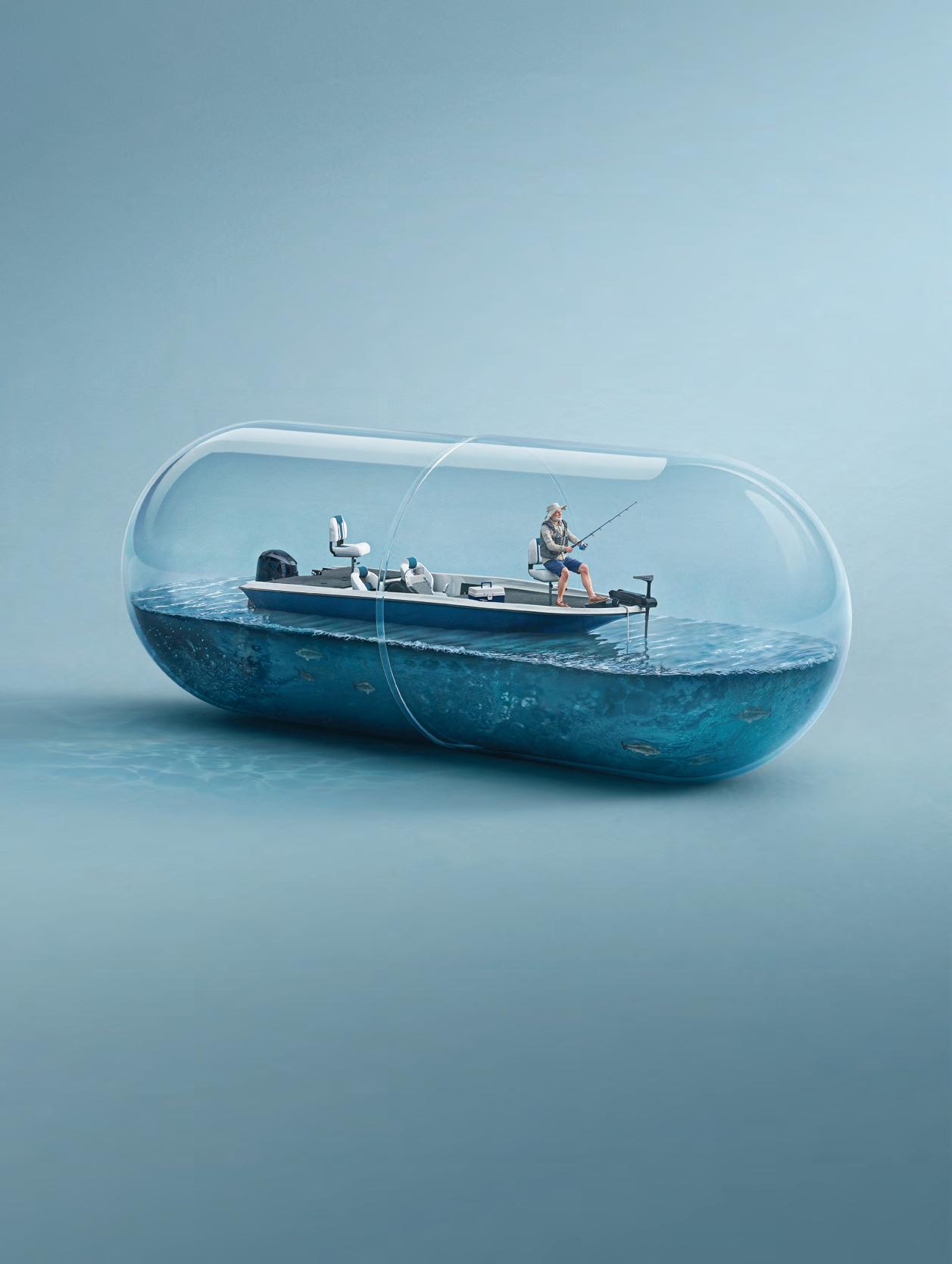



















There’s remote, and then there’s Pulley Ridge. Sitting over 100 miles o! the coast of Florida, this underwater plateau is where the Gulf of Mexico drops into the deep blue, and it’s earned a legendary reputation as one of the most productive, and challenging, shing destinations in the U.S.


By Astrid deGruchy
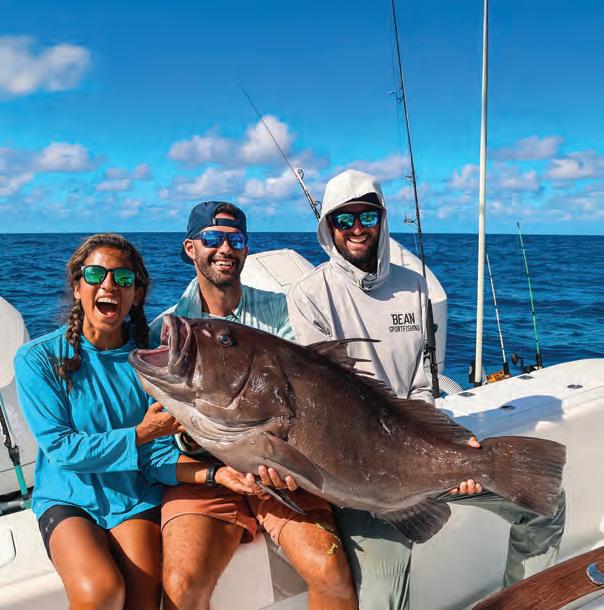

If you’re heading out there, you’ll need a serious o!shore machine. ink a 47’ Freeman or a Viking, something that can handle the long run and unpredictable Gulf conditions. is isn’t a trip for small center consoles or light tackle. Last time we were out there, we loaded up with PENN Fathom electrics paired with PENN Ally Electric rods & PENN International 50 VISX ready to drop into depths that test both your gear and your patience.
Using chicken rigs, we hauled in vermillion and yellow snappers in over 500 . of water that lled the box, but Pulley Ridge has a wild side where giant groupers and the occasional “what-the-heck-is-that” monsters lurk in the dark.
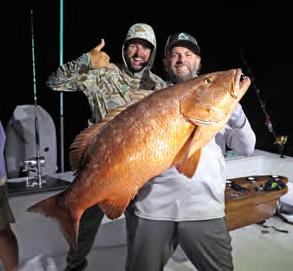
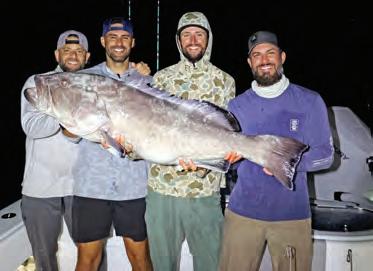
Pulley Ridge isn’t just another shing trip, it’s a rite of passage. e distance, the depth, the unknown, it all adds up to one of those bucket-list adventures every angler should do once in their life, especially with a crew of buddies who live for the chase. While you’re out there, you can even make a stop at the Dry Tortugas, another incredible o!shore destination rich in history and beauty.
Check out the full Pulley Ridge expedition on YouTube, only on Bean Sport shing TV.







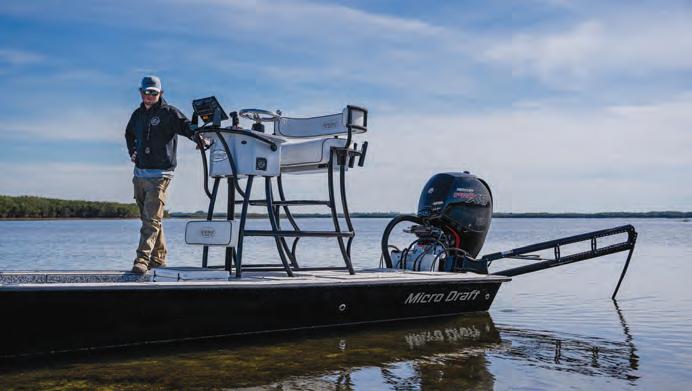



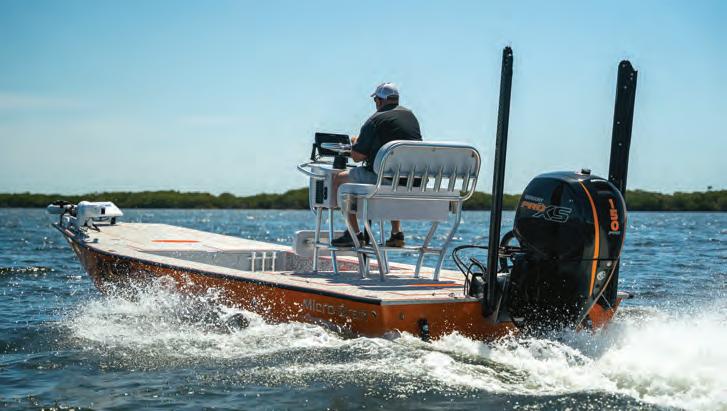

By Julie Graham
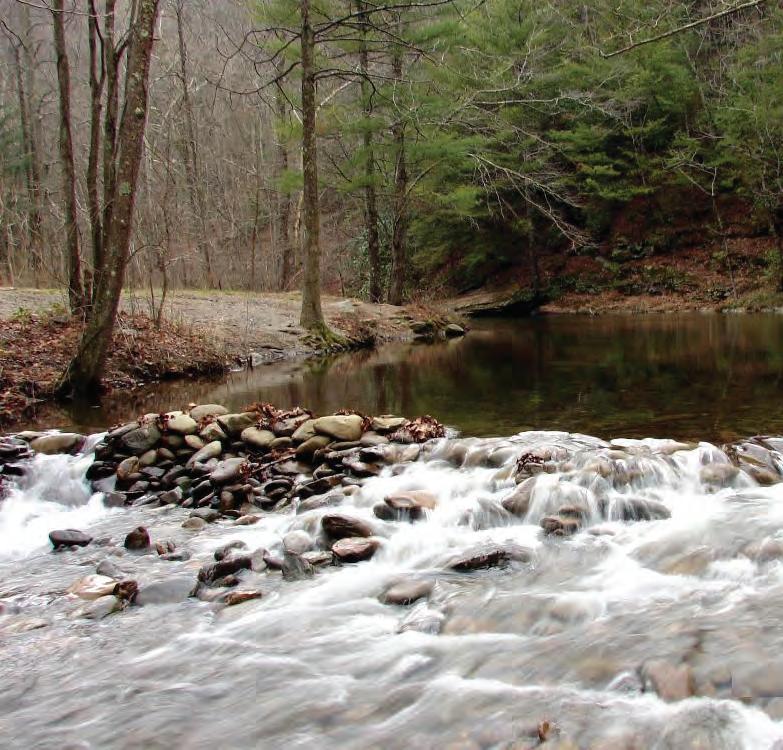
The Cherokee National Forest o!ers some of the best freestone trout shing in the Southeast. Spanning 650,000 acres across the Southern Appalachians, it’s the largest block of public land in Tennessee and it’s divided neatly in two by the Great Smoky Mountains National Park.
On the north side, mountain streams tumble through hemlock hollows toward Cosby. To the south, the waters of Citico Creek cut deep through wilderness ridges near the Unicoi Mountains. Together, they showcase the Cherokee’s range. From roadside creeks to backcountry runs, the forest o!ers anglers a taste of freestone Tennessee trout water.
Below the Great Smoky Mountains National Park boundary, Cosby Creek winds through the community of Cosby, Tennessee, o!ering accessible trout
water without the added park permit. ese lower stretches are regularly stocked by the Tennessee Wildlife Resources Agency (TWRA) and can provide productive shing throughout spring and fall. While access is somewhat limited, anglers will nd several bridges and pull-o!s along Highway 32 where they can wade in. e streambed is rocky and slick, with plenty of boulder pockets and undercut banks—good traction and careful footing are essential. Expect stocked rainbows with the occasional brown trout.
Inside the Park, the Cosby Campground section is ideal for bank shing and light wading, especially for those who prefer easy access close to trails and picnic areas. Brook trout dominate the upper reaches, while rainbows hold in the deeper pools below.
To the south, Citico Creek drains more than 20,000 acres of rugged country on the western edge of the Cherokee. Fed by the north and south forks rising in the Unicoi Mountains, Citico o!ers a blend of stocked and wild trout water—ideal for anglers who like a mix of easy access and adventure.
e TWRA regularly stocks Citico from Little Citico Creek to the Citico Creek Wilderness boundary, while the upper forks hold self-sustaining populations of wild rainbows and browns.
e Cherohala Skyway marks the southern edge of the Citico Creek watershed, and just driving it is worth the trip—sweeping vistas, ery fall colors, and the sound of water around every bend.
Autumn is prime time on both sides of the Cherokee National Forest. Water temperatures drop, trout feed hard before winter, and the hardwood ridges turn to ame.
• Match the Hatch: Early fall favors terrestrials; in November, go small with blue-winged olives, midges, and caddis emergers.
• Go Light: Clear, low ows call for 6X or 7X tippet and longer casts.
• Mind the Leaves: Dri leaves can snag a line—look for deeper pools below ri&es where trout hold under cover.
• Start Late: Cooler nights mean shing o en improves mid-morning as the water warms slightly.
For more information, including licensing regulations, visit the Tennessee Wildlife Resources Agency at https://www.tn.gov/twra.html.


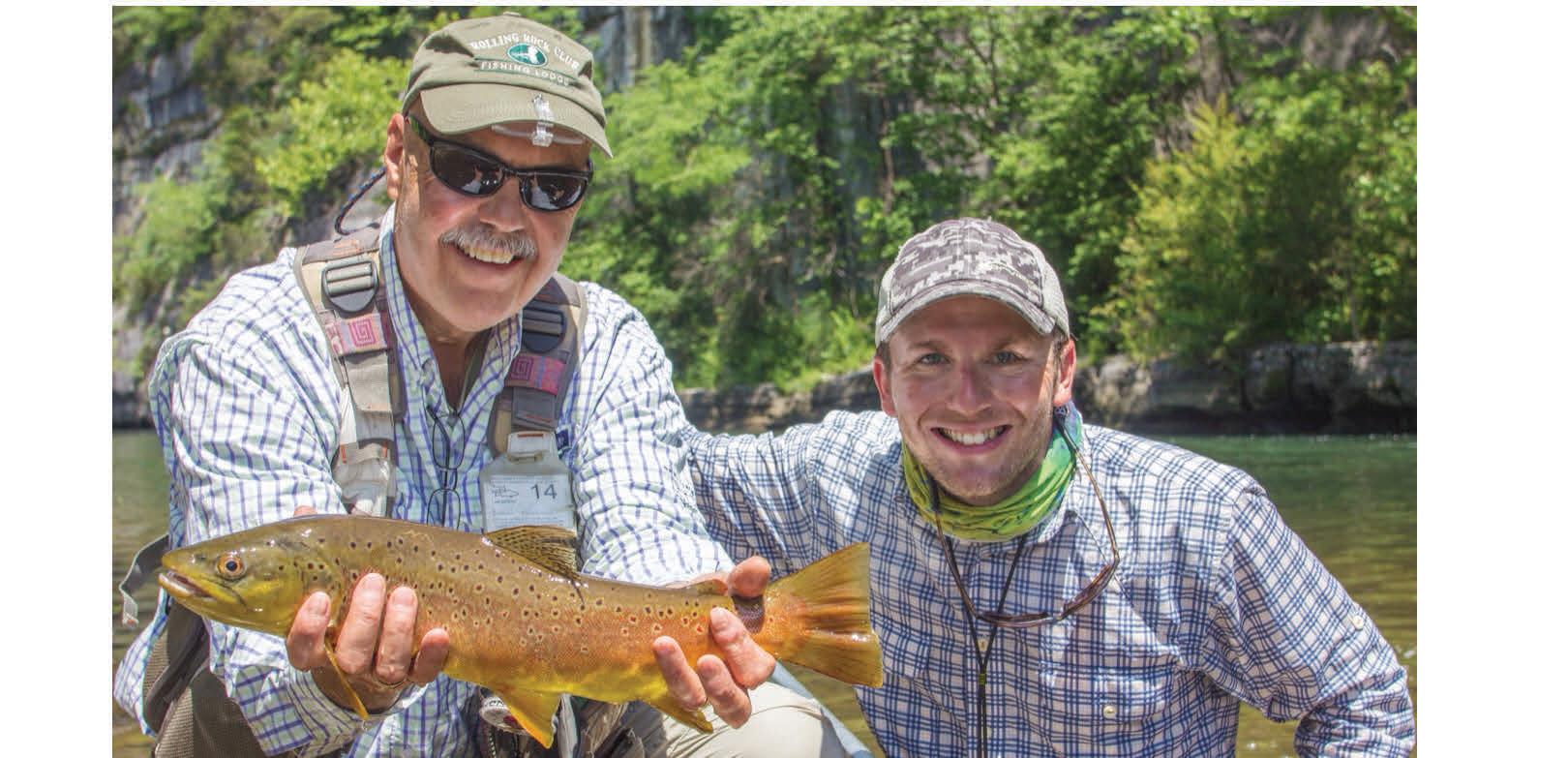












































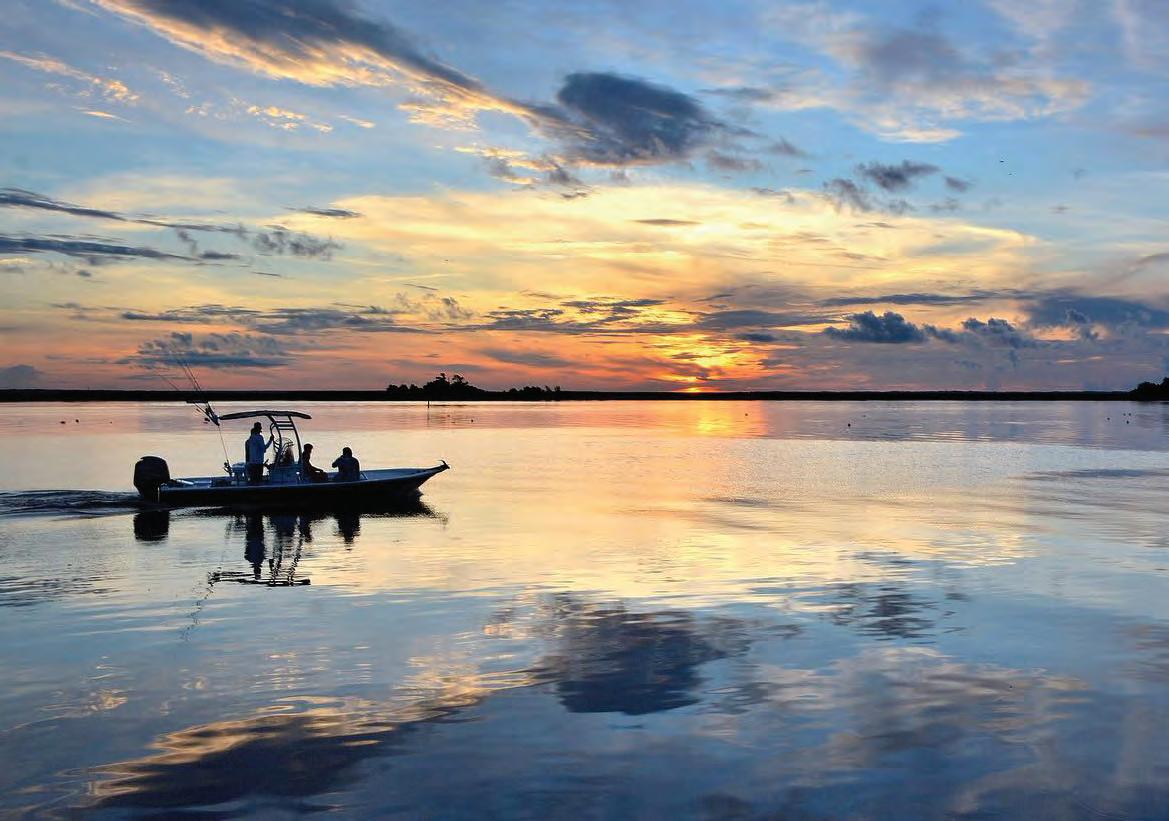


















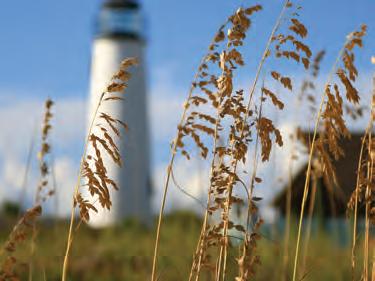








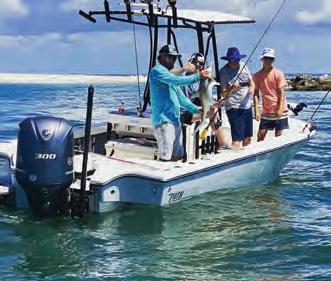





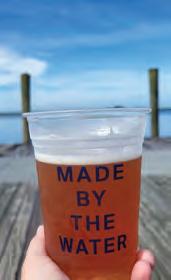
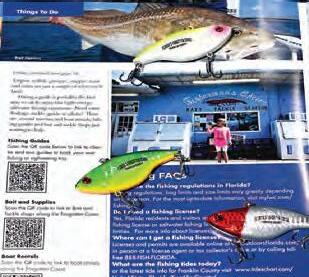











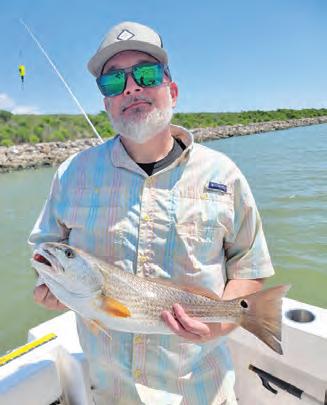
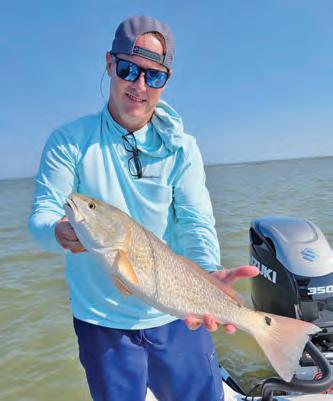

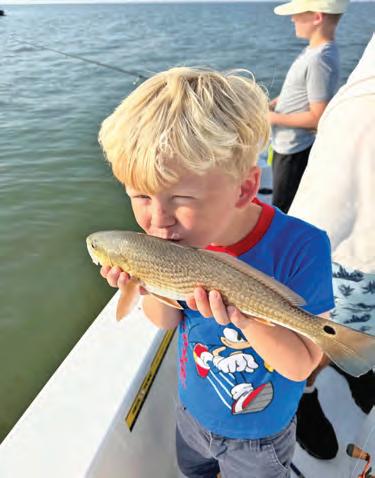



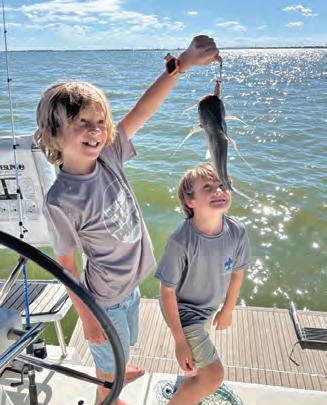
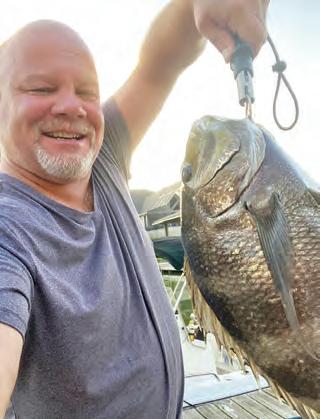


SOUTH SHORE HARBOUR MARINA
2400 South Shore Harbour Blvd, League City, TX 77573
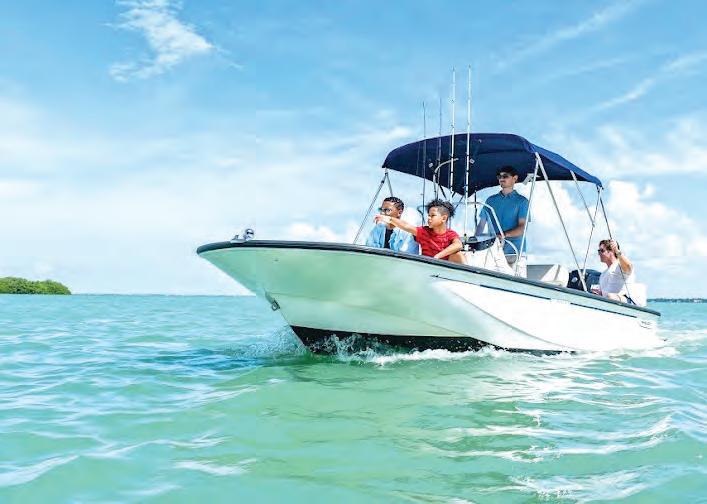
LAKE LEWISVILLE
1481 E Hill Park Rd, Lewisville, TX 75056
GRANDPAPPY POINT
1789 Harbor Dr, Denison, TX 75020
NORTH POINT MARINA
3681 Cedar Ridge Park Rd, Temple, TX 76502
WALDEN MARINA
12050 Melville Dr Suite 6, Montgomery, TX 77356
WATERPOINT MARINA
15320 TX-105 Suite 500, Montgomery, TX 77356
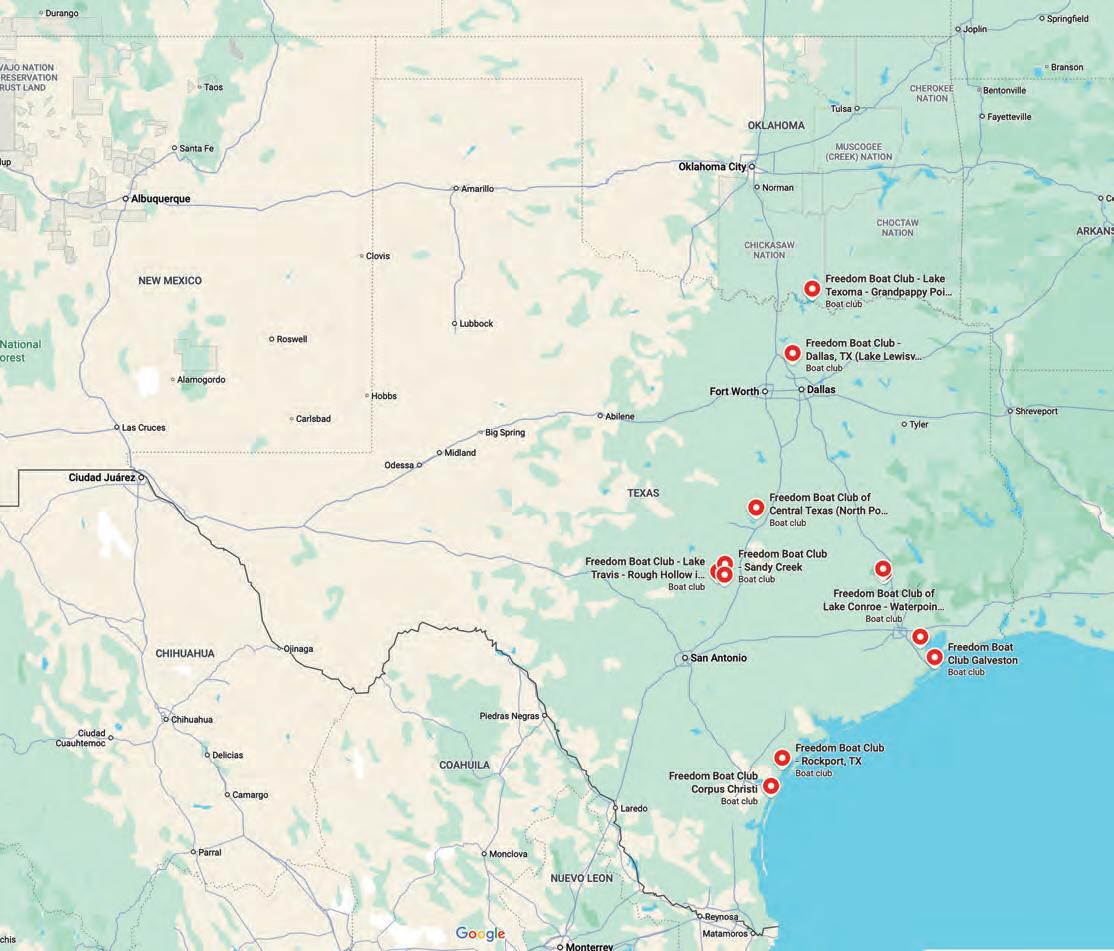
ROUGH HOLLOW IN LAKEWAY 105 Yacht Club Cove, Lakeway, TX 78734
SANDY CREEK MARINA
8714 Lime Creek Rd, Leander, TX 78641
1705 S Quinlan Park Rd, Austin, TX 78732
MARKER 37 MARINA
13317 S Padre Island Dr, Corpus Christi, TX 78418
PELICAN REST MARINA
7819 Broadway St, Galveston, TX 77554
COVE HARBOR YACHT CLUB 121 Cove Harbor Rockport, TX 78382














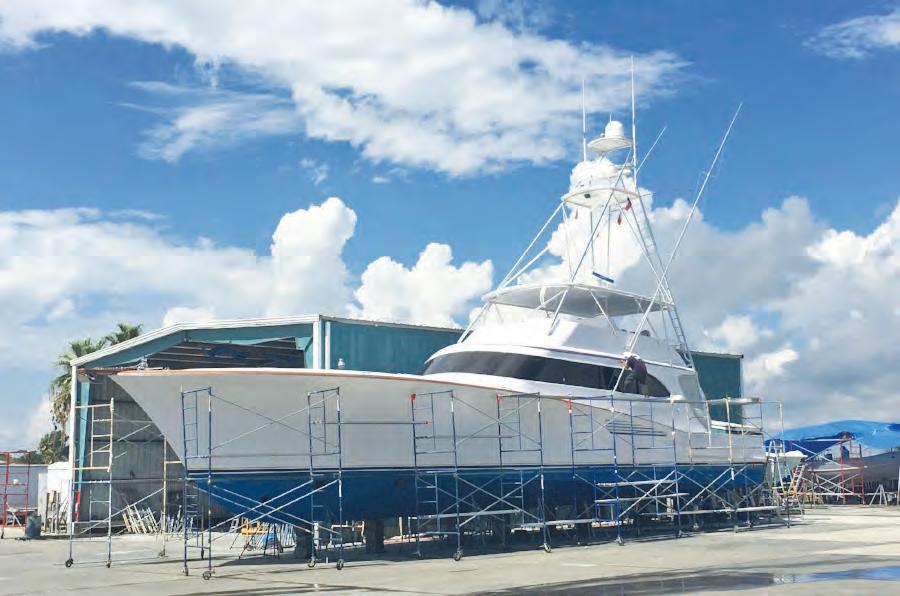





BY CAPT. MICHAEL OKRUHLIK
There’s just something magical about fall fishing on the Texas coast. The air cools, the bait thins out, and everything that swims gets a little hungrier. For me, it’s the holy trinity of the season — flounder migrations, trout and reds chasing shrimp under screaming gulls, and the early whispers of trophy trout time.
The Fall Flounder Run
Ah yes, the famous fall flounder migration — a Texas coast tradition. These flat ambushers stack up near the passes as they make their way to spawn in the Gulf, gorging on bait along the way. When I’m targeting flounder, I switch things up. My go-to is a scented soft plastic, preferably the Titan Series from Knockin Tail Lures. Not only are they scented, but they also have a rattling tail. Working this along the bottom will entice violent strikes. Since flounder love to bury themselves and wait in ambush, I keep that lure tapping bottom, twitching my rod sideways, whether I’m wading or boating. It’s a finesse game — part patience, part persistence — and when that telltale “thump” hits, it’s pure satisfaction.
Birds, Bait, and Mayhem
Then there’s the chaos of gulls dive-bombing over shrimp and schooling fish — a sight that’ll make any angler’s pulse jump. Fall often brings bigger trout into the mix, turning every cast
into a thrill. I prefer to use a heavier jighead (¼ to ⅜ ounce) to achieve the desired action without spooking the birds or the fish. Durable soft plastics help keep me in the fight longer, and I mash the barbs down for quick releases and faster re-casts. When the schools settle and the birds thin out, a topwater lure can coax the bruisers to rise — and few things beat watching a big trout explode on the surface.
Solunar Science and Timing the Bite
As fall rolls on, my focus shifts toward trophy trout — and timing becomes everything. I’ve followed solunar fishing tables since childhood, back when my grandparents’ calendars marked “good” and “poor” fishing days with little fish icons. Over the years, I’ve been both a believer and a skeptic, but I’ve noticed a pattern: my best bites often align with solunar peaks. Now, I plan my day around them. Instead of running and gunning, I’ll anchor in a promising area during a predicted feeding window and wait it out.
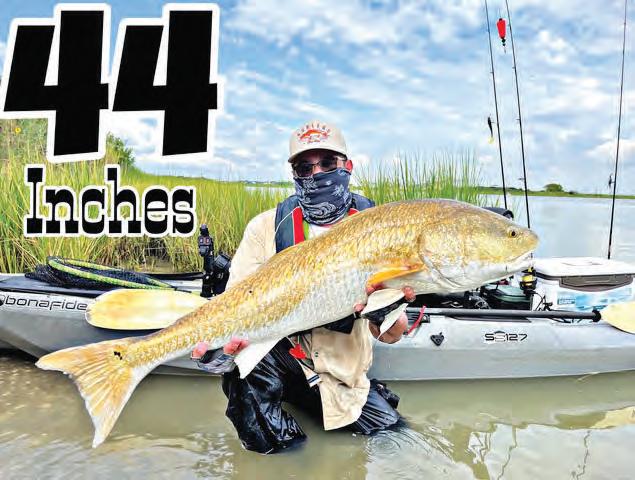
bent. For seventy glorious minutes, redfish hit every few casts, and sometimes we doubled up. My sons were smiling, the drag was screaming, and the solunar chart earned another believer that day.
So as the air cools and the fish feed up, grab a rod, bring a kid, and let the tides — and maybe the moon — guide your next adventure.
On a recent trip with my boys, we missed the morning bite but stuck it out for the next solunar cycle. We anchored near a grass edge meeting a sandy flat — and right on cue, rods


3
4
5

6
7
8
9
12














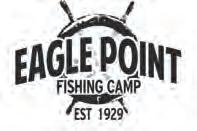
5:20 1.6 8:40 0.2 6:42 5:25
13 Thu 5:25 1.5 9:30 0.4 6:43 5:25
14 Fri 5:12 1.3 4:41 1.0 11:55 0.8 10:23 0.7 6:44 5:24
15 Sat 5:03 1.2 6:26 1.1 11:53 0.5 11:30 0.9 6:44 5:24
16 Sun 4:38 1.2 7:53 1.3 12:03 0.3 6:45 5:23
17 Mon 4:01 1.2 9:36 1.4 12:47 1.1 12:21 0.1 6:46 5:23
18 Tue 10:25 1.5 12:42 0.0 6:47 5:23
19 Wed 11:00 1.6 1:06 -0.1 6:48 5:22
21
22 Sat 12:47 1.6 2:50 -0.2 6:50 5:21
24
25 Tue 3:37 1.6 5:33 -0.2 6:53 5:21


6
2































6:40 5:26
12 Wed 4:58 1.4 7:04 0.2 6:41 5:25
13 Thu 5:04 1.3 8:05 0.4 6:42 5:25
14 Fri 4:59 1.1 3:15 0.8 12:06 0.8 6:43 5:24
15 Sat 4:22 1.0 6:30 0.9 11:12 0.6 10:02 0.8 6:44 5:24
16 Sun 3:21 1.0 8:00 1.1 11:05 0.3 11:17 1.0 6:45 5:24
17 Mon 1:43 1.0 9:07 1.2 11:17 0.2 6:45 5:23
18 Tue 10:04 1.3 11:36 0.0 6:46 5:23
19 Wed 10:59 1.3 12:01 -0.1 6:47 5:22
20 Thu 12:30 -0.2 6:48 5:22
21 Fri 12:01 1.4 1:06 -0.2 6:49 5:22
22 Sat 1:13 1.4
24





















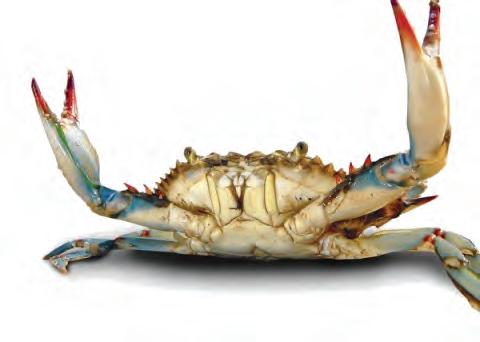






































































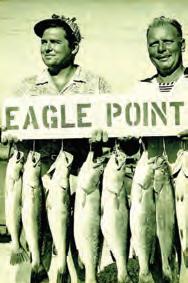
















CAPT. DAVID C DILLMAN
832-228-8012
galvestonbaycharterfishing.com
Perspective
Perspective — the ability to consider things in relation to one another. Strange way to start a fishing article, isn’t it? Yet, it’s something that’s been on my mind lately.
In life, we all go through changes — family, work, and spiritual growth. I’ve experienced plenty of that myself over the past few years. Spiritually, I’ve grown stronger and learned to view life through a new lens. My perspective on what truly matters has shifted. I suspect some of you reading this might feel the same way.
Now, you might be wondering — what does any of this have to do with fishing? Truth is, I’m not entirely sure! But as I sat down to write this, it just felt right to start with something real and personal.
The deadline for this article was October 15th, and to be honest, life has been hectic since then. Between juggling all my writing projects and squeezing in time on the water — even with the winds not being all that cooperative — the days have been full. But I wouldn’t trade it. Fishing keeps me grounded, and writing keeps me connected to all of you who share this same love for the outdoors.
This year has been a blessing in so many
ways. The biggest of all was celebrating my fifth wedding anniversary. The journey to get here hasn’t always been smooth, but when I said the words “I do,” my perspective on life changed forever. God and family come first — the rest falls into place from there.
So maybe that’s how this reflection ties back to fishing after all. When your priorities are in line, everything else — whether it’s life, love, or chasing redfish — just seems to flow a little better.
Now, let’s talk fishing.
Fall on the Bay
Redfish, redfish, and more redfish! That’s been the story lately, as it usually is every October. There have been a few trout mixed in during the day, but the spotlight belongs to those big reds. The Galveston jetty bull red run is on — not at its peak just yet, but there are plenty of fish along the rocks if you put in the time.
Inside Galveston Bay, we’ve seen a little bird activity, though nothing consistent so far. As water temperatures continue to drop moving into November, that bird action should really start to pick up. Keep an eye out for diving gulls — it’s a sure sign that trout are pushing shrimp toward the surface.
The speckled trout are beginning their usual fall transition, moving toward the northern reaches of the bay where the water is cooler and the bait is plentiful. The overall health of the bay looks strong this year — no major runoff from rainfall, good salinity levels, and plenty of shrimp in the system. That combination makes for solid fishing opportunities across the board.
Personally, November is my favorite month of the year on Galveston Bay. The weather is cooler,
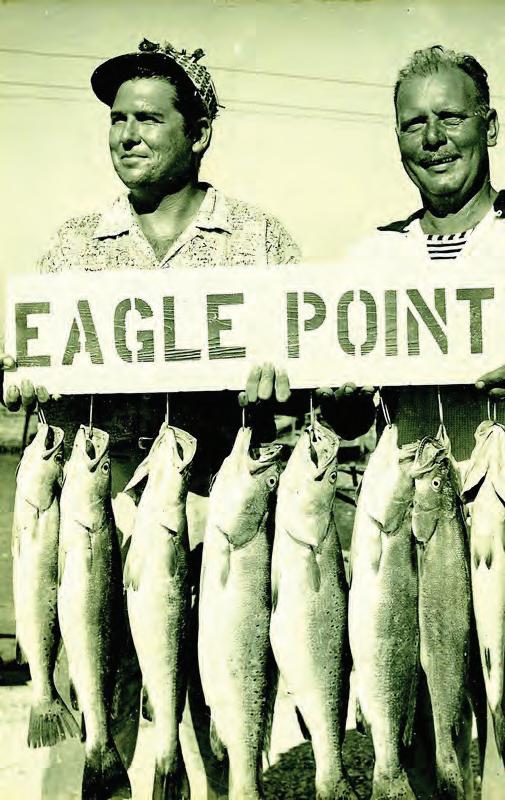
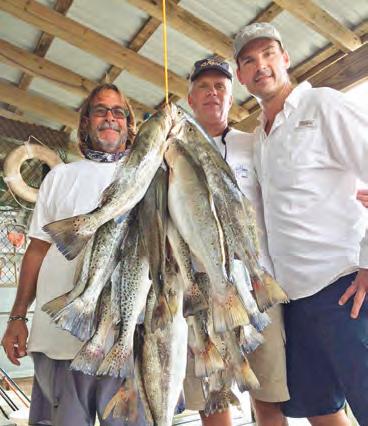
the crowds thin out, and the fish are active. There’s something special about those calm, crisp mornings — the kind where your breath hangs in the air, the sun rises slowly over the water, and the rod bends under the weight of a fat fall trout.
It’s a time that reminds me why we fish in the first place. Not just for the catch, but for the quiet, the reflection, and the connection to something bigger than ourselves.
As we head deeper into fall, I’m looking forward to the cooler weather, the steady bite, and a renewed sense of gratitude for every day spent on the water.
God bless, and be safe out there.
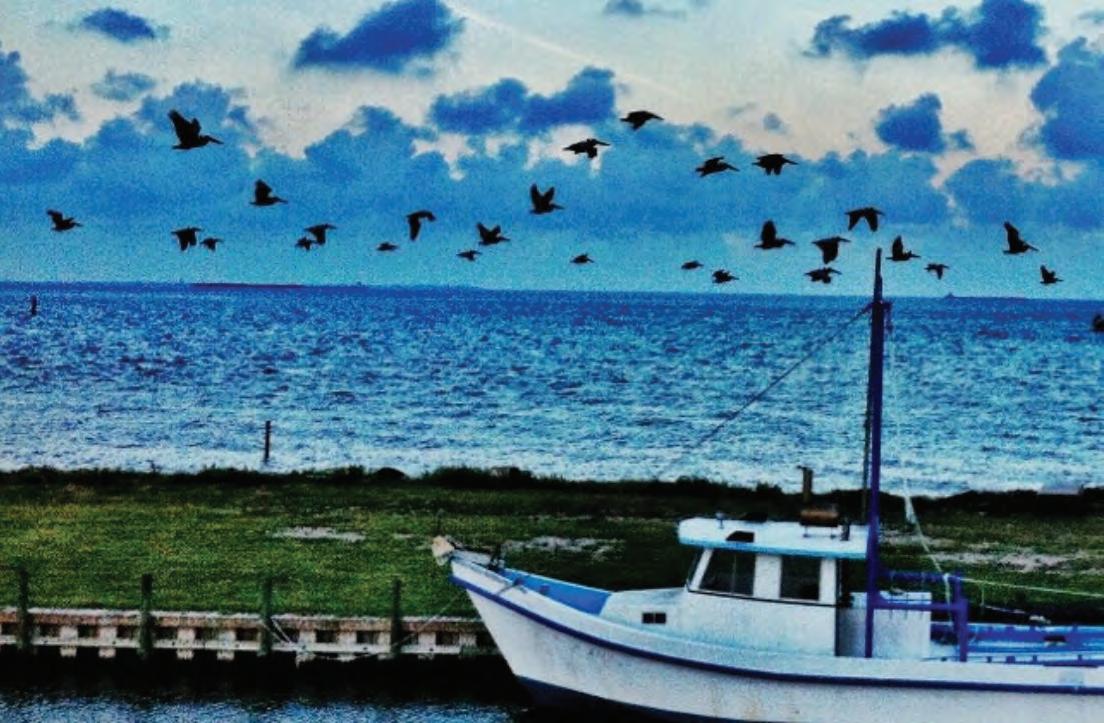
What’s made Eagle Point Fishing Camp unique since 1929 is its location and business model. Because it’s in the center of the Galveston Bay, EPFC allows anglers to conveniently fish a vast stretch of water spanning from Houston to Galveston. Using the same full-service concept as its date of establishment, EPFC has proven for nearly a century that easy access to the water combined with a skilled staff creates the perfect fishing experience. Along with the boat ramp, boat storage, live bait for purchase, tackle shop, and RV park, EPFC has always had a fleet of shrimp boats to supply the bait that so many of their regular customers desire. Their successful commercial shrimping business has been an intricate part of what makes EPFC unique.



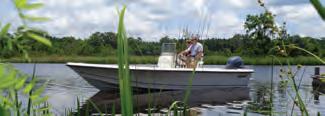
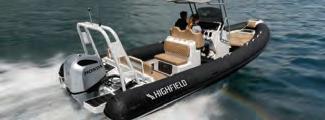














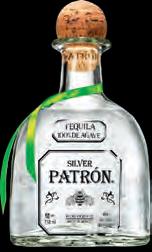


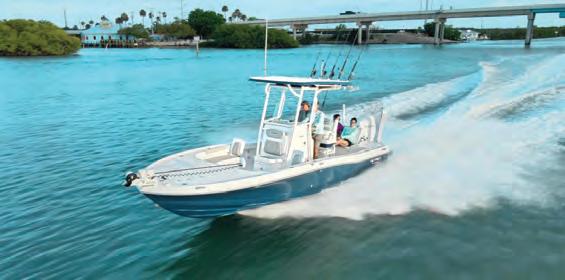




Fishing Academy captpaul@gofishgalveston.com www.gofishgalveston.com
Most of the fishermen we know have traded their rods for rifles and shotguns—at least for a few months. From November through mid-March, the trout bite slows as the cold water lowers their body temperature and metabolism. During these chilly months, trout often act more like piggy perch or hardheads than the aggressive feeders we enjoy the rest of the year.
Winter trout fishing can be rewarding, but it’s also more work than fun. The cold can be biting, and the fish are sluggish. Still, with fewer boats on the water, you can enjoy peaceful days on the bay without the summer crowds. For those willing to brave the chill, the payoff can be excellent action once you find where the trout are holding.
Cold fronts—those “northers” that blow through regularly—have a big impact. The stronger the front, the worse the fishing immediately afterward. These fronts stir up the bay, turning the water the color of chocolate milk and sometimes dropping levels by two or three feet. After a big front, many shallow shell reefs and flats are left high and dry, forcing trout into deeper holes and channels.
It usually takes three to four days for tides and clarity to return to normal. Once things settle, you can expect several days of good fishing. Trout typically suspend in water six to nine feet deep, especially around oil and gas platforms, deep shell reefs, and oyster beds. If you know a particular well pad has produced in the past, anchor up and work it thoroughly for 15 to 30 minutes. You can also drift over reefs, then return to your previous spots once the tide changes direction and begins moving again.
During winter, remember that the fish stay deep—so keep your bait near the bottom. You won’t often see working gulls since shrimp have migrated out, but you may still find trout along shorelines near deeper structure. They tend to feed before a front moves in, instinctively stocking up before the next cold blast.
The lack of live bait this time of year keeps many anglers home. Some don’t have confidence in lures, and others just don’t like using them. When you can find live bait, fish it under a popping cork, setting your leader about four to seven feet deep. You can also free-line shrimp or use a slip weight depending on the bottom. When shrimp aren’t available, try live finger mullet or mudfish, hooked through the dorsal fin or tail.
Make long casts, and once the bait hits the water, let out enough line for it to sink where it landed. This helps counter the current and keeps your bait in the strike zone longer. Retrieve slowly,

pausing occasionally until the bait reaches the boat. Move often and cover plenty of water— winter trout fishing rewards persistence.
Artificial lures in winter require patience and practice. This is not the ideal season for beginners to start learning them. Presentation is key—lift the rod tip gently as you retrieve to keep the lure near the bottom where trout are holding. Bottombumping plugs with two sets of hooks are a solid choice; the extra hook often means the difference between a missed strike and a landed fish.
If you wade fish in winter, remember trout have a thicker coat of slime for protection. Always carry a landing net; they’re slippery enough in summer, but in winter, with numb fingers, they’re almost impossible to grab barehanded.
Dress in layers so you can adjust to the changing temperature throughout the day. Staying comfortable makes a big difference in how long you’ll last out there.
Winter fishing on Galveston Bay may not be easy, but it’s peaceful, challenging, and often surprisingly productive. With a little patience, preparation, and the right attitude, you can turn those cold, quiet days into some of your most memorable catches.
See y’all on Galveston Bay!
Capt. Paul Marcaccio- Professional Guide with 40 years of experience, U.S.C.G.










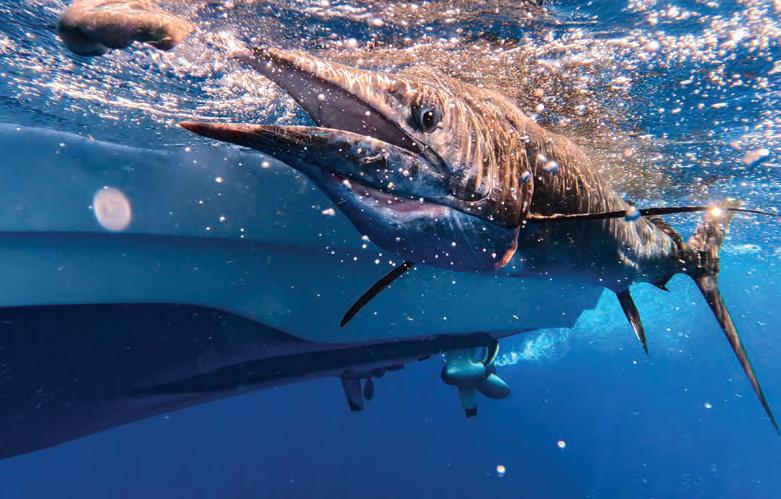
By Will Schmidt
Sail!sh are known as the fastest !sh on the planet, but they o er more than blazing speed to those who chase them o Florida’s east coast, such as I did on a recent !shing excursion. Spectacular surface bites and astonishing acrobatics make these !sh a coveted catch for even the most experienced anglers. For !rst timers, it’s an adrenaline !led !ght that will stick with you long a er the !sh swims back into the cobalt blue Atlantic. is trip was special for a few reasons. First, we had rising country star Ben Gallaher (IG: @Ben_Gallaher) with us. Ben is an avid outdoorsman and bass !sherman, but he had never caught a saltwater !sh. I was also excited to !sh with some new friends, Capt. Geoge Gozdz of “Unfathomed” (IG: @captgeorgegozdz) and Chris Bishop, VP of marketing at Yo-Zuri (iG: @Yozuri_Lures).
A er just a short run o Port St Lucie, we set our spread, and I could sense any strikes would likely be dramatic. e water was crystal clear and glass at giving us a great view of any action. e !rst !sh in, came crashing into the spread chasing and slashing at a bait with its bill. Unfortunately, as aggressively as it came in, it turned and retreated without eating.
As we reset the spread anticipation grew to !nd Ben’s !rst saltwater adversary. Fortunately, another sail came in a smashed the right rigger. However, it ran right at us, and we were never able to get tight. Undaunted, we set up again. Soon all the baits were nervously darting on the surface. e le atline erupted as the sail slashed, splashed and devoured the bait. Ben was on, and this !sh leapt and twirled with all the acrobatics of a Cirque du Soleil show. ere was still another to eat and moments later we doubled up. Both !sh cooperated with plenty of arial antics and a er a good !ght we had both !sh to the boat. To say Ben was pumped to land his !rst bill!sh is an understatement. Amped up with adrenaline and ready for more he could only beam with an ear-to-ear grin and say “let’s go!”
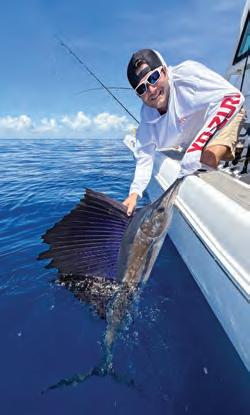
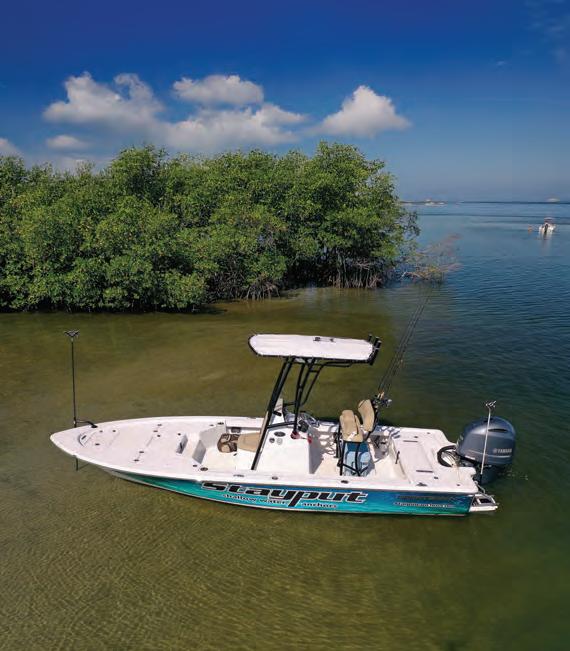


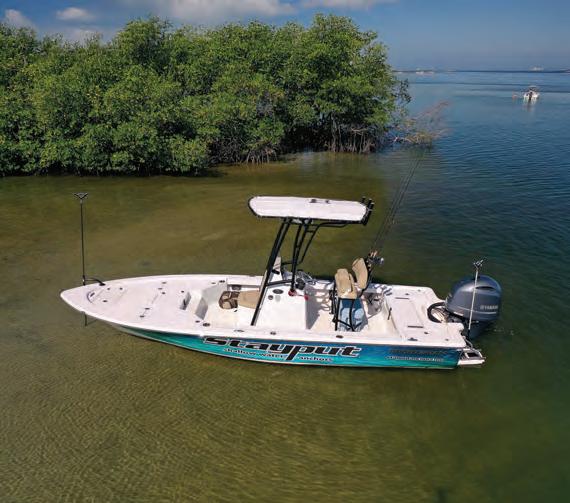

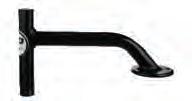



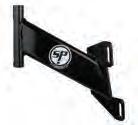

Fall !shing o of Port St Lucie o ers warm water and a hot bite without having to battle high winds and cold temperatures o en associated with winter sail!sh !shing in Florida.. Moreover, it’s not di&cult at all. We were simply bump trolling large, bridled thread!ns. Bridling helps the bait last longer and doesn’t allow for the hook to turn into the thread!n causing a missed strike. Our tackle was medium Penn Carnage rods with Authority reels lined with Yo-Zuri Super Braid topped with Yo-Zuri’s Disappearing Pink Fluorocarbon leader. ese setups gave us the sensitivity to feel the “eat” and the stealthiness to fool even the most cautious of !sh in these clear conditions. On your next trip don’t rush past these exciting sails, stop for some fun acrobatic action.
Will Schmidt is a seasoned tournament angler who has been writing about shing for more than two decades. Follow Will on Instagram @saltynstrong.



It’s no fsh tale when you run with a John Deere. You can get everything done faster and easier, so you get more time on the water. Plus, our special offers make them the catch of the day.



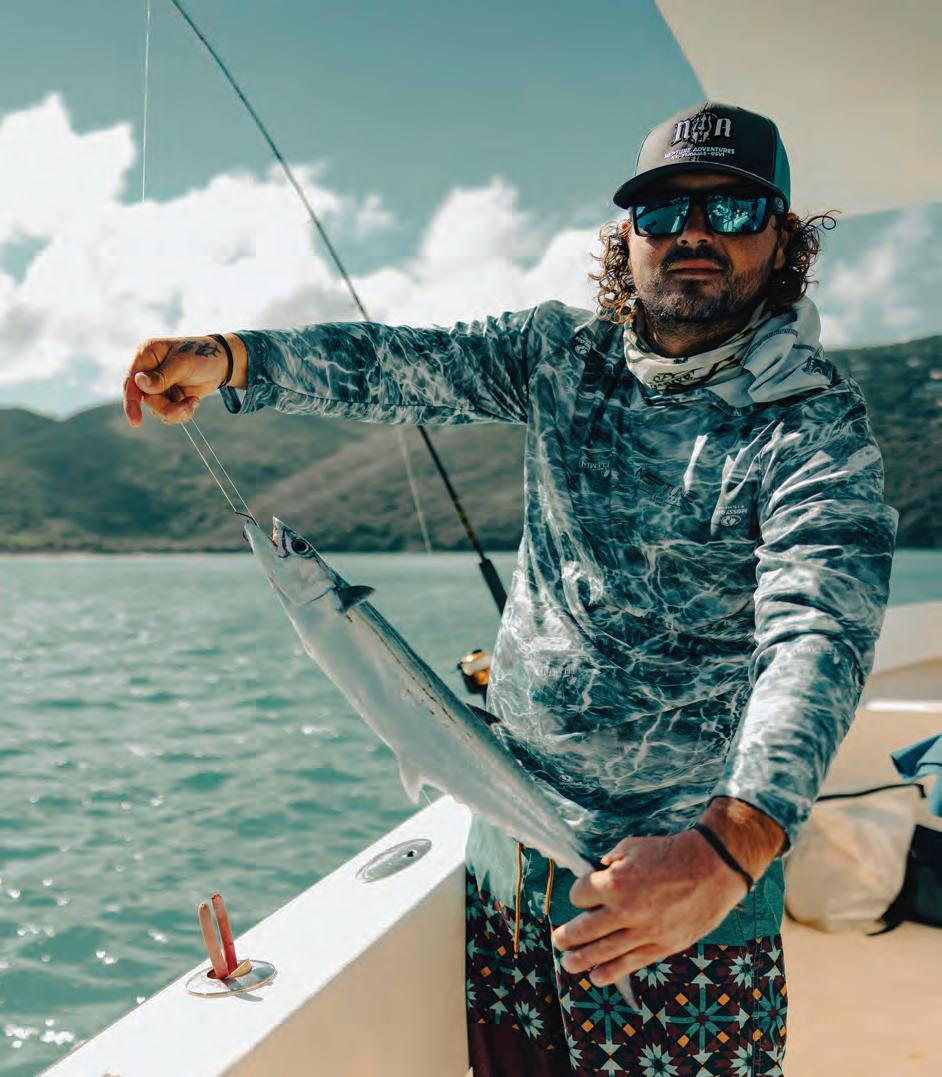
Anglers from around the world come to the U.S. Virgin Islands to !sh our incredible turquoise waters for trophy blue marlin, black!n tuna, wahoo and mahi-mahi. And with no passport required for U.S. citizens, it’s easy to plan your next !shing trip. Whether you want to set o on a crewed charter complete with a professional captain or prefer to simply cast a line from one of our scenic white-sand beaches, get ready to reel in the big one. Plus, many out!tters can customize your trip to include thrilling underwater activities like snorkeling.
O the island of St. Croix choose your own adventure, whether you’re looking to !sh o shore for mahi-mahi, wahoo, king!sh, tuna and blue marlin, or nearshore for tarpon, snapper, mackerel, rainbow runner and jacks. Seasoned crews who have been !shing the waters of USVI for decades will take you on customizable charters in search of catching your trophy !sh of a lifetime. Some out!tters o er complimentary !sh cleaning services, so all you have to do is throw your coveted catch on the grill or in the pan!
From St. John, troll for big game !sh—blue marlin, sail!sh, tuna, mahi-mahi and wahoo—on an o shore charter. Opt for a nearshore charter to catch bonito, barracuda, rainbow runner, snapper and
sharks. Or join an inshore bottom !shing trip to cruise the USVI’s deep-water reefs. Whether you’re an experienced angler or a novice needing some guidance, you’ll !nd an out!tter equipped with all the top-of-the-line !shing gear you’ll need for a successful day at sea.
About 20 miles north of St. omas is the North Drop, an area unparalleled for its big game !sh. Book a deep-sea !shing charter and sail over to this corner of the Caribbean that boasts more blue marlin bites per boat than any other place in the world. Half-day to 10-hour o shore bait !shing charters are ideal for adventurous anglers eager to experience the island’s famous North and South Drops. A mix of trolling and live baiting makes for mega catches, with yellow!n tuna, wahoo, mahi-mahi and blue marlin the most common catches of the day.
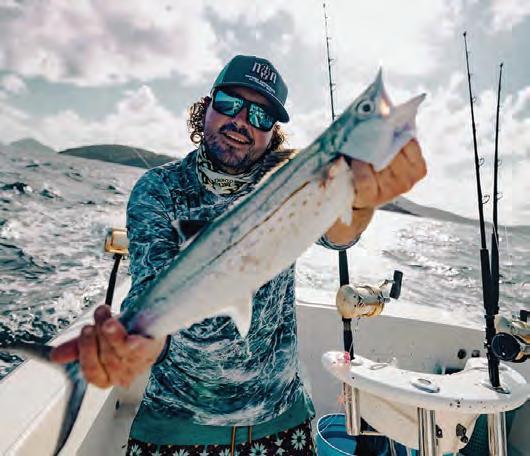
Surrounded by pristine blue waters, it’s no surprise that fresh seafood is a delicious part of nature’s bounty in USVI. You’ll !nd plenty of seafood-focused restaurants, from elegant !ne dining to laid-back waterfront eateries. Some out!tters even o er a stop at a seaside restaurant as part of their !shing excursions.







When the leaves start to turn and the water temps dip, bass anglers know what time it is—the fall feed. Bass are chasing bait like crazy, and it’s one of the best times of year to put big !sh in the boat. e trick is knowing what to throw as the season shi s. Here are !ve proven fall baits that will help you stay on the bite no matter what the lake throws at you.
Spinnerbait: Few baits scream “fall” like a spinnerbait. When the wind picks up and shad push shallow, it’s hard to beat a double willow blade ashing through the chop. e ash and thump imitate a school of eeing bait!sh, and hungry bass can’t resist. Target windy points, creek mouths, and shallow ats anywhere the bait’s getting pushed around.
Lipless Crankbait: is one’s all about covering water. Fall bass are constantly on the move, and a lipless crank lets you !nd ’em fast. Burn it over grass, rip it free when it hangs up, and hold on! at reaction bite is what fall !shing’s all about. Red or chrome patterns are money this time of year, especially when bass are chasing shad.
Jerkbait: Once the water clears and the temps drop into the 60s, it’s jerkbait season. Work it with a twitch-twitch-pause cadence, and you’ll mimic dying bait!sh to perfection. is lure shines around suspended bass that hang
o points or creek channels.
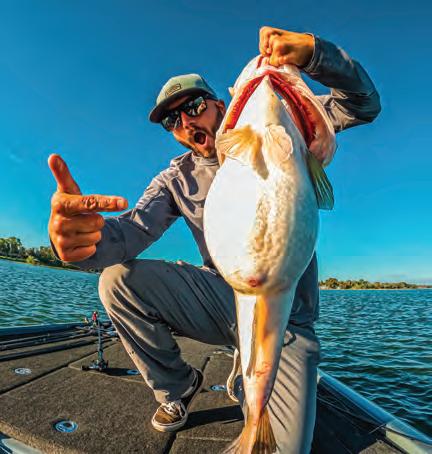

RJust be patient. Sometimes the bite comes right when you least expect it, on that long pause. Squarebill Crankbait & Swimbait: To round out your fall lineup, keep a squarebill and a swimbait on deck. A squarebill is your go-to for shallow cover stumps, rocks, laydowns, anywhere bass are ambushing bait in the backs of creeks. Meanwhile, a so or hard-bodied swimbait is ideal when you’re around big !sh feeding on larger forage. Slow-roll it through bait schools or along creek channels for some of the biggest bass of the year.
Fall is all about !nding the bait, and these !ve lures all mimic shad in their own way. Whether you’re slow-rolling a spinnerbait through wind-blown banks or ripping a lipless crank across a at, the !sh are feeding and it’s your job to get in on the action. Grab a few of these baits, follow the shad, and enjoy one of bass !shing’s most exciting seasons!
Tyler Woolcott is a professional tournament angler and guide. Check out his website at www.tylerwoolcott shing.com.

ed!sh are one of the most sought a er game !sh by inshore !shermen from Texas to the Carolinas. ey are great !ghters; they are great tasting; and they are perfect for sight !shing because they love super shallow water. Red!sh are part of the drum family and have four nostrils. is tells us that scent is their chosen sense while searching for food in dark and murky water.
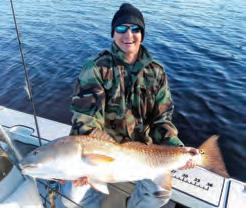
e best red!sh lure that I have ever used is the 3-inch Berkeley Gulp! Shrimp. Berkeley Gulp! products are the smelliest baits that I have ever smelled and red!sh love them. ere are probably other stinky baits that work, but I haven’t found one that is comparable to Gulp! products. e best colors are anything with brown and gold glitter. Rootbeer and new penny are the best choices. e second best lure for catching red!sh is the gold or copper weedless spoon. ese are great search baits when you cannot see the red!sh. A slow retrieve with almost constant contact with the bottom is the way to !sh these lures. ese lures are exceptional for casting. ey cast a mile and let you cover a lot of water as you search for the schools of red!sh in the shallows.
e third best lure for red!sh are 3- and 4-inch paddletails rigged weedless. is is another great search bait for covering large areas of water. You will want to retrieve your paddletail in a similar way to your spoons. Make sure to bounce it o the bottom as you slowly retrieve it.
Contact Capt. Mike Smith, owner of Fish Your Ass O Charters, at (561) 339-2317, contact@ shyourasso .com or shyourasso .com.




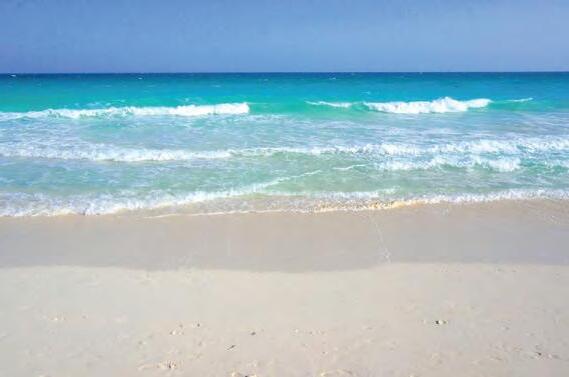
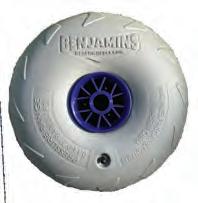


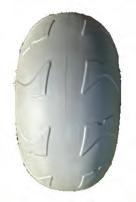

“I never expected it to be so beautiful that it takes your breath away.”
— Kaya C., on Stauer Opals
In a quaint village, nestled between rolling hills, lived a young woman with a deep appreciation for gemstones. Her grandmother gifted her a delicate cross pendant adorned with opals. "e opals shimmered with a mesmerizing play of colors, reflecting hues of blues, greens, and fiery oranges. Her grandmother shared the legend of the opals, believed to bring hope, purity, and luck to those who wore them.
Using this story as inspiration, Stauer brings you the Opal Spirit Cross Pendant. With over 2 total carats of Kyocera lab-created opals set in .925 sterling silver encased in yellow gold, this pendant is a radiant celebration of beauty and craftsmanship. Each opal captivates with a kaleidoscopic dance of fiery oranges blending into oceanic blues, streaked with flashes of vibrant green that seem to come alive with every movement. "e shimmering opals are skillfully arranged to create an enchanting, otherworldly glow, embodying the spirit of hope and harmony. "is breathtaking combination of color and craftsmanship is available as a limited availability of only 930 pieces, making it a rare and treasured addition

to your jewelry collection. Plus, when you order today, you’ll receive the Opal Spirit Cross Pendant at an impossible price of just $59 normally $149!
Don’t miss your chance to own this exclusive tribute to timeless elegance and meaningful symbolism.
Jewelry Speci!cations:
• Pendant: 2 ½ ctw. Kyocera lab opals and DiamondAura® accents. Yellow gold-finished .925 sterling silver setting
• Chain: 18" gold-clad .925 sterling silver chain
Opal Spirit Cross Collection

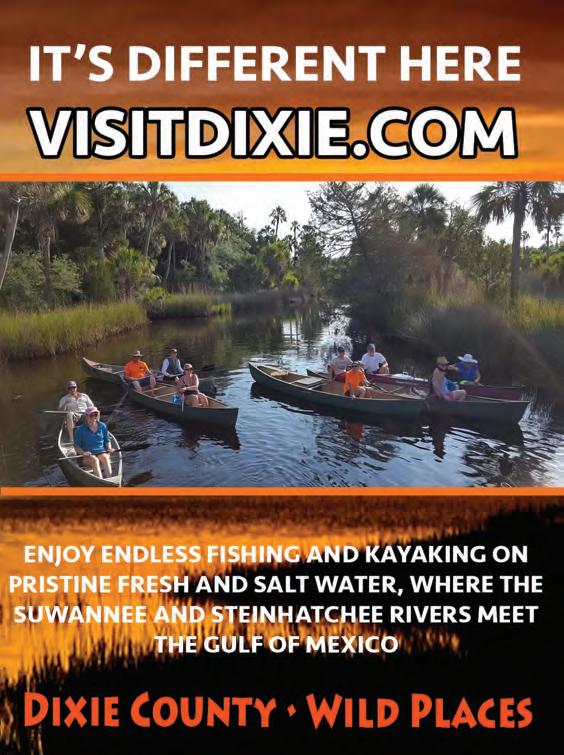
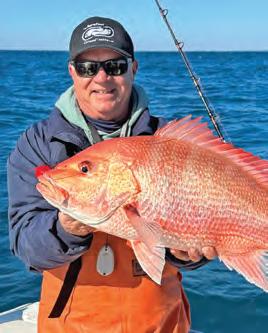

ovember is almost a completely unique month of the year. We’ll start getting the !rst real cold fronts, and this will pile the bait on temp breaks. Structure on the bottom will certainly hold the grouper and snapper on the bottom, but pay attention to the recorder and the marks in the mid water column. ese marks can be a number of the targets we’re looking for. Black!n are a given during the month of November, but it’s “go time” for wahoo and yellow!n. e bait can stand colder water than the pelagics. is is one of their biggest defensive strategies, and why you should have a (realistic) jig ready that can !sh 75-150 feet deep around the bait balls because the surface water will likely be as much as a few degrees warmer that the surface water due to the cold wind blowing overhead. Keep live baits out on circle hooks and ourocarbon and try to get some lower in the water column. ese live baits are black!n bombs ready to go o , but I am always drawn to the bottom in search for the grouper and snapper. Some of these same live baits or frozen cigs and sardines on the correct jigs (hint, hint) are irresistible to the !sh I’m really looking for. I want the big grouper and snapper bite. When you !sh the correct baits using the correct presentation, you’re not asking them to eat it, you’re MAKING them eat it! BAM! is is also African pompano candy. e jig in the mid to lower part of the water column is deadly, but if there’s no bites !shing it deeper and deeper all the way to the bottom, bring it up to the surface and repeat the process.

A trolling motor will really help in this controlled dri , keeping the bow forward into the wind and/or current. is will keep the light line out back and the baits on or near the bottom slightly back depending on the current. is is the bottom line: bag the trolling crap, post up on stacks of bait with dedicated crew for the light line and/or jig and dedicated crew on the bottom to generate groceries in the cooler. is is my kind grocery shopping.
Learn the drill of how to !sh the entire water column nice and quiet with beautiful baits and tactics for results. Dress with proper !tting foul weather gear and take plenty of photos and videos you can enjoy for years to come.
Learn more from Tim Barefoot on his YouTube channel and at barefootcatsandtackle.com.
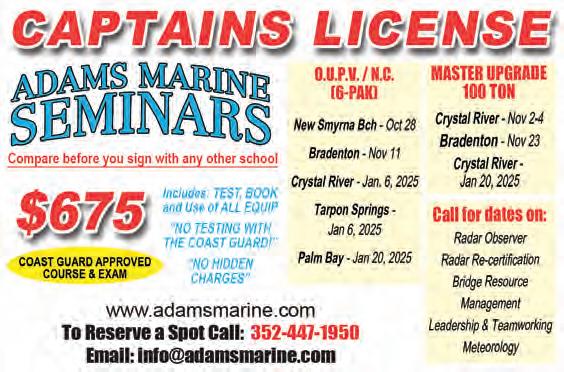
Spot Call: 352-447-1950
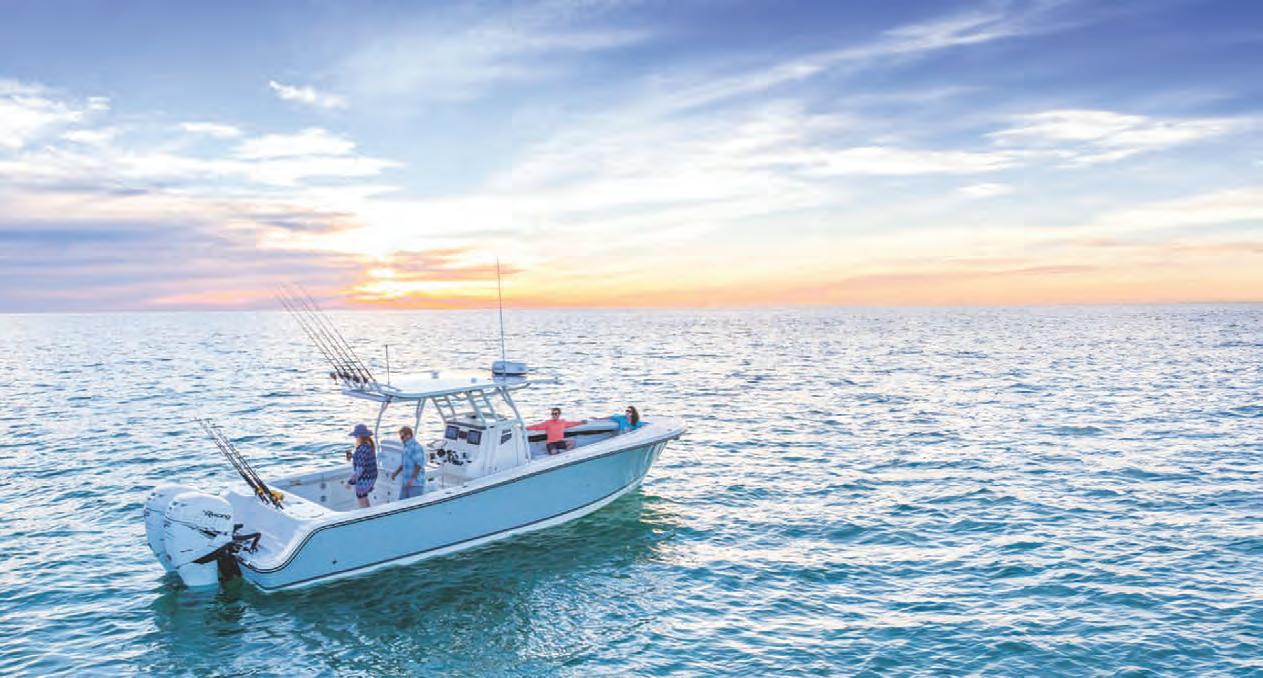


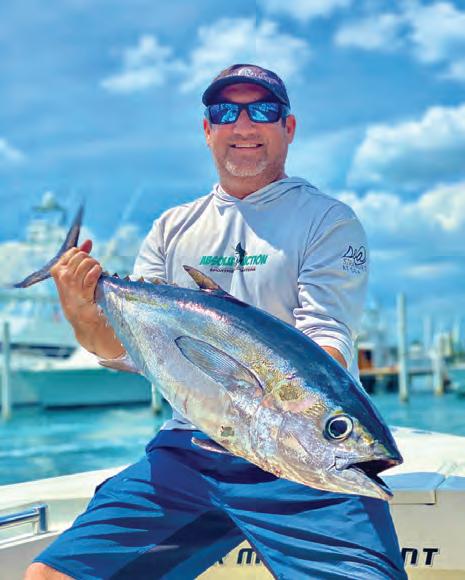





It was a warm summer afternoon and my wife and I were mingling with the best of them. The occasion was a 1920s-themed party, and everyone was dressed to the nines. Parked on the manse’s circular driveway was a beautiful classic convertible. It was here that I got the idea for our new 1920s Retrograde Watch.
Never ones to miss an opportunity, we carefully steadied our glasses of bubbly and climbed into the car’s long front seat. Among the many opulent features on display was a series of dashboard dials that accentuated the car’s lavish aura. One of those dials inspired our 1920s Retrograde Watch, a genuinely unique timepiece that marries timeless style with modern technology.

With its remarkable retrograde hour and minute indicators, sunburst guilloche face and precision movement, this design is truly one of a kind. What does retrograde mean? Instead of displaying the hands rotating on an axis like most watches, the hands sweep in a semicircle, then return to their starting point and begin all over again.

Retrograde watches by the big brands can set you back thousands; one recent offering from a big French fashion house is selling for more than $150,000! But because we’ve designed the 1920s Retrograde Watch in-house, we can offer it to you for just $99!
This watch is so wildly popular with our customers that we’re actually concerned about running out; we only have 937 729 left for this ad!
Join more than 1 MILLION smart people who love stauer watches

Watch Specifications:
• Precision movement
• Stainless steel case, caseback and crown
• Retrograde hour and minute indicators
• Water-resistant to 5 ATM




• Brown genuine leather band
• Fits wrists up to 8"
1920s Retrograde Watch
$399 $99* + S&P Save $300


*Special price only for customers using the offer code.





“An elegant and exciting timepiece that every collector will love.”
— George Tomas, internationally renowned watch expert



“[A] unique and beautiful timepiece.”
— Carlos C., Los Banos, CA




